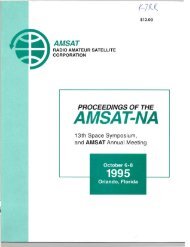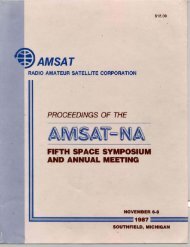- Page 1 and 2: jL 7££ $15.00 A MSAT RADIO AMATEU
- Page 3 and 4: Copyright © 2000 by The American R
- Page 5 and 6: Table of Contents (continued) APRS
- Page 7 and 8: Welcome It is with great pleasure
- Page 9 and 10: had characteristic perigee values o
- Page 11 and 12: the digital experimenters will want
- Page 13 and 14: Fig.1, P3E Rendered overvieW
- Page 15 and 16: 10 Fig.3, P3E Line Overview
- Page 17 and 18: Amateur Radio On-board the Internat
- Page 19 and 20: of "transportable stations" which c
- Page 21 and 22: The packet bulletin board system on
- Page 23 and 24: Side view of the EVA handrail ada
- Page 25 and 26: wishing to review the status of the
- Page 27: 2. CUBESAT DEVELOPMENT PROGRAM Aft
- Page 31 and 32: N 0"1 4 .3 2 NOTES: IN..ESS OTI£RW
- Page 33 and 34: Payload services are designed to pr
- Page 35 and 36: Assembly is simple. The RF circuit
- Page 37 and 38: Level 2) To receive some beacons fr
- Page 39 and 40: Amateur radio frequencies (and lice
- Page 41 and 42: 2. These organizations could move t
- Page 43 and 44: 5 "Space System Developments at Sta
- Page 45 and 46: On 10450, it may not be enough to f
- Page 47 and 48: Converters A converter converts one
- Page 49 and 50: 44 falls offby 3 dB from the highes
- Page 51 and 52: And higher still: S and C Bands Her
- Page 53 and 54: Summary The higher bands on P3D off
- Page 55 and 56: Mountaintop, P A 18707 (570) 868-56
- Page 57 and 58: product using another media. Those
- Page 59 and 60: Ground Track The unit vector (V LCH
- Page 61 and 62: sin((J) = The velocity vector is th
- Page 63 and 64: FIGURE 2 DEFAULT SETTINGS FOR A TIM
- Page 65 and 66: identified under the AMSAT Output F
- Page 67 and 68: The command and control mode VN dat
- Page 69 and 70: Most of the TNC-2 based TNCs have a
- Page 71 and 72: Ahstract Distributed Processing Goe
- Page 73 and 74: SETI@)home's power derives from cle
- Page 75 and 76: ARGUS@home won't happen overnight.
- Page 77 and 78: Figure 3: Graham Vincent, SEll Leag
- Page 79 and 80:
o lola••ec("dmg1en'lth ~ 339 31
- Page 81 and 82:
On AO-27 and UO-14 the downlink is
- Page 83 and 84:
little planning even urban settings
- Page 85 and 86:
A Spread Spectrum Wideband Transpon
- Page 87 and 88:
nadir-pointing attribute of the Pal
- Page 89 and 90:
signal, one to monitor the station'
- Page 91 and 92:
Instanffune for the FT-IOO Anthony
- Page 93 and 94:
The flIst problem is that you canno
- Page 95 and 96:
Due to the way that the FT-IOO work
- Page 97 and 98:
Auxiliary Receiver InstantTune lets
- Page 99 and 100:
Similarly, the "itstart.bat" file i
- Page 101 and 102:
Step 1 Quit from InstantTrack putti
- Page 103 and 104:
Once you have turned on , control t
- Page 105 and 106:
DOWN step DATA 1 3 Tuning Complete
- Page 107 and 108:
EXAMPLES: 1. Change COM 3 to use IR
- Page 109 and 110:
The name of the satellite must matc
- Page 111 and 112:
eacon 29.4081 cw Auxiliary Fixed Tr
- Page 113 and 114:
• Check to see that the COM port
- Page 115 and 116:
Even with P3D in orbit and operatin
- Page 117 and 118:
'atelllte :je:?lmJC!gNumbeet::'~ Ep
- Page 119 and 120:
REFERENCES Specific technical infor
- Page 121 and 122:
The potential of two-way satellite
- Page 123 and 124:
Igates with operators that have vol
- Page 125 and 126:
any time while also monitoring the
- Page 127 and 128:
universal frequency where ALL APRS
- Page 129 and 130:
DISTRIBUTING LIVE SAT TRACKING DATA
- Page 131 and 132:
The Houston AMSAT Net I earned myHa
- Page 133 and 134:
VNIW Real Audio Geostationary Comme
- Page 135 and 136:
finnware (verses EPROM) and the EEP
- Page 137 and 138:
Rotor Calibration First and foremos
- Page 139 and 140:
Deadband Commanded Value ,/ For exa
- Page 141 and 142:
of dissimilar radio models. For exa
- Page 143 and 144:
Calibration Limits Command Meaning
- Page 145 and 146:
and the T APR EasyTrakTM AzlEI Ro
- Page 147 and 148:
Software Design If the world was fl
- Page 149 and 150:
Rotor Control Window 1 (Normal Mode
- Page 151 and 152:
Automatic Weather Balloon Tracking
- Page 153 and 154:
148
- Page 155 and 156:
Camera Tracking Recent events have
- Page 157 and 158:
BEARING is only accurate if you are
- Page 159 and 160:
Applications of PIC Microcontroller
- Page 161 and 162:
TNC must simultaneously be in commu
- Page 163 and 164:
This leads to the selection ofa mod
- Page 165 and 166:
Distributed system for LEO satellit
- Page 167 and 168:
a sender and a lot of receivers, po
- Page 169 and 170:
Figure 2. Processes in the main app
- Page 171 and 172:
The new G3RUH software modem for th
- Page 173 and 174:
Figure 3. Multirate processing Figu
- Page 175 and 176:
MODE-V/I EASY-SATS FOR EVERYONE Bo
- Page 177 and 178:
usable downlinks across a 30 Khz ba
- Page 179 and 180:
• First is the requirement for a
- Page 181 and 182:
Thayer School of Engineering at Dar
- Page 183 and 184:
mechanical support as well as the s
- Page 185 and 186:
In tandem with data acquisition and
- Page 187 and 188:
opportunities. Modularity by design
- Page 189 and 190:
AMSAT SYMPOSIUM PRESENTATION PHASE
- Page 191 and 192:
emember awaiting the sun to go down
- Page 193 and 194:
communications, this will open up a
- Page 195:
About the Author ... Dominick ''Dee
















